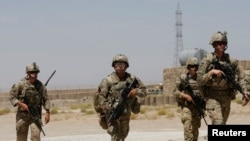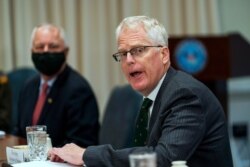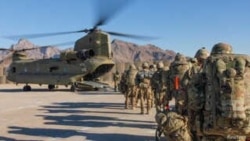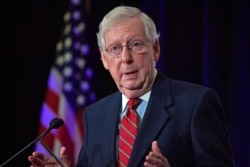The Pentagon is bringing home more American service members in the coming weeks, following President Donald Trump’s order to remove about 2,000 troops from Afghanistan and 500 troops from Iraq before next year’s U.S. presidential inauguration.
“By January 15, our force size in Afghanistan will be 2,500 troops. Our force size in Iraq will also be 2,500 by that same date,” Acting Secretary of Defense Chris Miller told reporters at the Pentagon on Tuesday.
Miller said the troop reduction did not “equate to a change in U.S. policy or objectives” in the global war against terrorism and would be conducted in a way that protects U.S. troops, diplomats, intelligence officers and allies. He did not take questions following his statement.
National Security Advisor Robert O’Brien laid out a similar plan in October, which the Pentagon would not confirm at the time.
Miller said he spoke early Tuesday with several key leaders to update them on the U.S. plans, including leaders of Congress, NATO Secretary General Jens Stoltenberg and Afghan President Ashraf Ghani.
“President Ghani highlighted the caliber of our troops, which he noted has always been more important than the quantity. We continue to stand with him as his government works toward a negotiated settlement for peace,” Miller said.
NATO now has more troops in Afghanistan than the United States, and military officials say the Pentagon is urging them to maintain their numbers in the country even as Trump reduces troop levels.
U.S. forces toppled the Afghan Taliban in 2001 following an invasion that had strong public support in the wake of the September 11 terrorist attacks carried out by al-Qaida, whose leadership was being harbored in Afghanistan. But as the war has continued, American public opinion has changed, and President Trump won office in 2016 promising to withdraw from foreign conflicts.
A senior defense official told reporters in a background call Tuesday the cuts will result in “no elimination of capabilities” on the ground and were sufficient to keep U.S. forces, the Afghan people and U.S. allies protected.
However, several current U.S. military officials told VOA on background that a significant reduction of forces would lead to at least some reduction of the scope of U.S. missions, if all missions indeed continue in Afghanistan.
“We are currently working through the detail planning to determine what effect it (the reduction) will have on particular capabilities,” one military official said on condition of anonymity Tuesday.
Former senior military officials said a proposed troop drawdown from Afghanistan under the current conditions was worrisome, especially during a presidential transition period.
“This is a very odd time — it is hard to see the true strategy behind these machinations,” one former senior military official told VOA on condition of anonymity.
News of the potential military changes began circulating on Monday and brought swift criticism from experts, former officials and even some of Trump’s biggest allies, including Senate Majority Leader Mitch McConnell.
“There is no American who does not wish the war in Afghanistan against terrorists and their enablers had already been conclusively won. But … a rapid withdrawal of U.S. forces from Afghanistan now would hurt our allies and delight the people who wish us harm,” McConnell said Monday.
McConnell called on the president to continue applying pressure “until the conditions for the long-term defeat of ISIS (Islamic State) and al-Qaida have been achieved.” Without that, he warned an exit would be reminiscent of “the humiliating American departure from Saigon,” Vietnam, in 1975 and would be worse than the U.S. withdrawal from Iraq in 2011, which he said fueled the rise of the Islamic State terror group.
Republican Congressman Adam Kinzinger told VOA an Afghanistan drawdown without the right conditions on the ground was “a mistake,” adding that it would destroy leverage that could be used in peace negotiations designed to end the fighting between the Afghan government and the Taliban.
"There's negotiations ongoing; you always negotiate from a position of strength,” he said.
Democratic Senator Tim Kaine criticized the move Tuesday.
“We've always said that withdrawal should be conditions based and not arbitrary but this is worse than an arbitrary date, it's a purely political date,” said the Virginia lawmaker.
Fellow Democrat and veteran, Senator Tammy Duckworth of Illinois, questioned the timeline of the withdrawal.
"To bring the troops home with just literally weeks of planning — actually no planning at all — sets up a logistical impossibility,” Duckworth said Tuesday. “How do we bring all those troops back?”
Trump abruptly fired Defense Secretary Mark Esper one week ago and replaced him with Miller, the former director of the National Counterterrorism Center.
Esper sent a classified memo to the White House earlier this month expressing concerns about a precipitous withdrawal in Afghanistan as violence remains high and peace talks drag on, according to the Washington Post.
Miller’s newly appointed senior adviser, retired Army Col. Douglas McGregor, has called for a complete withdrawal of U.S forces from Afghanistan, along with shutting down the U.S. embassy in Kabul. Anthony Tata, who has been performing the duties of under secretary of defense for policy since Tuesday, also has called for a full withdrawal from Afghanistan.
“The conspiracy theorist in me would have to say that now we seem to understand why the president purged the civilian leadership at the Pentagon,” a former senior military official said on the condition of anonymity Monday.
In a memo to the Department of Defense on Monday, Acting Secretary of Defense Miller listed bringing “the current war to an end in a responsible manner” among his top goals.
About 4,500 American troops are currently serving in Afghanistan, where the U.S. has been fighting for nearly two decades to prevent al-Qaida and other terror groups from establishing a safe haven from which they can carry out attacks on the U.S. and its allies. About 3,000 U.S. troops are in Iraq to advise Iraqi partners as they root out remnants of Islamic State.
A speedy, hastened withdrawal from Afghanistan in a few weeks would be "costly and much more dangerous," than a slower, more deliberate withdrawal based on the security conditions on the ground, according to military officials. And General Kenneth “Frank” McKenzie, the top military officer in charge of operations in the Middle East, has repeatedly said that the Taliban have still not shown conclusively that they are going to break with al-Qaida.
Michael O’Hanlon, a senior defense fellow at the Brookings Institution, pointed out that President-Elect Joe Biden could raise the numbers in Iraq and Afghanistan back up “fairly easily” once he takes office on January 20.
“It’s not smart, but it’s also not the end of the world. … It’s a lot better than (going to) zero,” said O’Hanlon.
Last month, Trump tweeted that the U.S. should have all its troops who are serving in Afghanistan home by Christmas.
Shortly afterward, Trump’s national security adviser said the president’s tweet that U.S. troops should be home from there by December 25 was a “desire” rather than a military order.
“Right now, we're on a path with our European allies — we went into Afghanistan together; we're going to come out together — we’re on a path right now that looks like about 4,500 this fall and a smaller number in January and February,” national security adviser O’Brien said October 16.
Average daily enemy-initiated attacks in Afghanistan were up 50% from July 1 to Sept. 30 of this year, compared to between April 1 and June 30, the Special Inspector General for Afghanistan Reconstruction, also known as SIGAR, said earlier this month.
U.S. Forces-Afghanistan (USFOR-A) has characterized overall enemy-initiated attacks this quarter as “above seasonal norms.”
Katherine Gypson, VOA Afghan Service contributed to this report.












